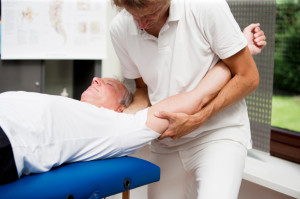 Strain-counterstrain, or positional release, is a gentle, hands-on treatment approach designed to restore balance and health to the body by placing the body in positions of least tension or strain, usually related to positions of greatest comfort and maintaining these positions long enough for the tissues to slacken and permanently revert back to their original length. As discussed in the description of myofascial release, fascia is a type of connective tissue.
Strain-counterstrain, or positional release, is a gentle, hands-on treatment approach designed to restore balance and health to the body by placing the body in positions of least tension or strain, usually related to positions of greatest comfort and maintaining these positions long enough for the tissues to slacken and permanently revert back to their original length. As discussed in the description of myofascial release, fascia is a type of connective tissue.
Fascia fibers are similar in function to a rope, in that they possess little elasticity. They are designed to be extremely strong and maintain a heavy load. While fascia fibers are non-contractile, meaning that they do not possess the ability to contract and elongate, they are programmed to reflexively respond to severe stress or trauma by shortening their length.
This is a protective response that helps the organism survive. The fibers will shorten in direct opposition to the traumatizing force, thus creating a “counterstrain” to the strain. The traditional direct osteopathic manipulative approaches can further exacerbate this counterstrain by applying even more stress into the direction that the fibers are opposing.
This may temporarily approximate bones into seemingly more correct anatomical positions, but it does nothing to reprogram the counterstrain response. This may partially explain why the gains achieved by the direct osteopathic manipulative techniques tend to be relatively temporary. It may also explain why this treatment approach, particularly those that use the high-velocity thrust techniques, can lead to injuries.
Lawrence Jones, DO, discovered the effects of this positional release technique by accident. He describes attempting to help a 30-year-old male find relief from four months of severe low back pain after completely failed attempts by two other osteopaths. Over a month of failure with his own osteopathic manipulations, the patient suggested that his condition may improve if he could sleep. Jones devoted that treatment session to adjust the patient’s position joint by joint in small increments hoping to find some position comfortable enough for the patient to sleep that night.
After 20 minutes of this gradual strain-counterstrain process, the patient finally expressed feeling almost complete comfort. Jones described this position of comfort as a “wild, grotesque position.” Jones decided just to leave him alone in that position, thinking that this position of relief was the best thing that had happened to the patient in four months.
Jones actually went on and treated other patients for 20 – 30 minutes while the young man remained in a position of comfort. When Jones returned to the patient, he stood up from that position completely erect for the first time in four months and in almost completely no pain. As much as it baffled him, this was an epiphany moment for Jones.
He attempted using the concept of sequentially positioning patients into positions of complete or near-complete comfort. He reports that his failure rate decreased from about 30% to about 5%. Through practice, he determined that the time spent in the position of comfort could be shortened to 90 seconds and the technique could be used for many conditions. Through the 1950s, he further developed the concept, including evaluation techniques and treatment protocols.
Ultimately, the Jones Institute was established in 1988.  The concepts of strain-counterstrain that I learned from the Jones Institute challenged my understanding of how the body responds to stress. They taught me how easily the body could achieve balance by simply assisting it in the direction of ease and finding positions of comfort rather than directing the body into positions based on their apparent anatomically correct position.
The concepts of strain-counterstrain that I learned from the Jones Institute challenged my understanding of how the body responds to stress. They taught me how easily the body could achieve balance by simply assisting it in the direction of ease and finding positions of comfort rather than directing the body into positions based on their apparent anatomically correct position.
Strain-counterstrain has been instrumental in the process of developing my own treatment style. I prefer to let the body dictate the course of every treatment rather than strictly follow any specific treatment protocol. I incorporate the concepts of positional release into virtually every treatment by following the patterns of resistance that I detect, supporting the body into whatever direction it needs in order to obtain balance.
